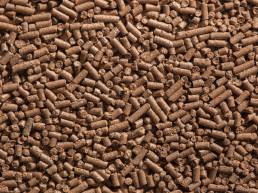Ustilago Maydis
At the moment a lot of corn smut (field fungus) is found in maize fields as a result of prolonged drought, sometimes combined with sprinkler irrigation this growing season (2018).
Corn smut
Corn smut affects the maize plant in the field and is caused by the smut Ustilago maydis. The fungal spores end up in the collar through, among others, wind, insects, rain or sprinkler irrigation and thus spread throughout the plant. Once the spores are inside, the maize plant responds by abnormal tissue formation, mainly in the corn cob, in the shape of bumps (greyish galls, see picture). These bumps burst, releasing brownish black spores. These spores can be left in the soil and subsequently keep their germination capacity for years.
Corn smut can not be controlled by pesticides and crop rotation has little effect as the spores are dispersed by wind. Furthermore the maize quality and yield are adversely affected by this fungus. Maize has, among others a lower dry matter content and often has high levels of, among others, the mycotoxins aflatoxin (Afla), zearalenone (ZEA) and fumonisin (FUM) (Abbas et al., 2015 and Abbas et al., 2017). The weakened plant is also more susceptible to other fungi, especially the Fusarium fungus.
Fusarium is a field and storage fungus and can produce various mycotoxines before and after silage. These are, among others, Afla, ZEA, FUM and tricothecenes like deoxynivalenol (DON) and T-2. These mycotoxins have an adverse effect on cattle health and production.
T-2, DON: Reduced feed conversion, Reduced feed intake, Laminitis
ZEA: Oestrus and other fertility problems, Cyst formation, Rejection
T-2, DON and AFLAB: Diarrhoea, Ketosis, Rumen problems, Intestinal hemorrhage, Gastroenteritis
AFLA: Contaminated milk, Reduced milk production, Higher risk of mastitis
Mycotoxins and animal health
The symptoms in cattle depend on the kind of mycotoxin. E.g. ketosis and diarrhoea are caused by tricothecenes. Stunting, foot problems and metritis are caused by DON and T2 causes skin lesions. A high level of DON leads to a reduction in food intake or in extreme cases complete feed refusal. ZEA affects the hormonal system and has an adverse effect on fertility (oestrus problems, cysts and abortion) and can cause a drop in milk production. In addition ZEA affects sperm quality. Aflatoxine can end up in milk by means of contaminated feed and also has adverse effects on human health.
The adverse effects of mycotoxins are not manifested immediately and will only show after some time (sometimes weeks to months). For this reason E.F.S. recommends regular mycotoxin analyses of raw materials and feeds.
The adverse effects of mycotoxins can be controlled by the use of products that deactivate mycotoxins. Tox-Aid® is an effective product that limits the damage that mycotoxins can cause.
Tox-Aid®
With its combination of bentonites, deactivated yeasts, and a mixture of herbs Tox-Aid® is a natural method to limit the harmful effects of mycotoxins. Bentonite is known for its capacity to bind certain mycotoxins, while E.F.S. dectivated yeast also deactivates by means of enzymes. The enzymes transform the structure of mycotoxins into a harmless form which is excreted. The added herb extract with, among others, rosemary and silymarin, supports the liver and reduces oxidative stress in the animal.
Dosages
Depending on the kind and the level of mycotoxins in feed/feed material the recommended dosage for Tox-Aid® is established. In the table you will find the standard dosages. E.F.S. has an extensive database with information on mycotoxins.
| Contamination level | Dosage |
| High | 2,5 kgs |
| Low | 1,0-1,5 kgs |
| Preventative | 0,5-1,0 kgs |
Table 1. Dosage Tox-Aid® in kgs per ton feed
Should you like to receive more specific infomation about mycotoxins, or our product Tox-Aid® please contact the E.F.S.-team.
You may also like
EFSA: No increase in risk for consumer when formaldehyde is used in animal feed
March 27, 2014
In February 2014, the EFSA published an article on the use of formaldehyde in animal feed. When formaldehyde is used in animal feed, there is no increased intake of formaldehyde by the consumer. Therefore, the EFSA does…




